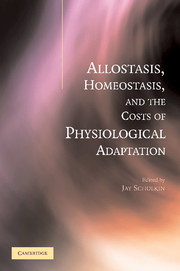Book contents
- Frontmatter
- Dedication
- Contents
- Preface
- Contributors
- Introduction
- 1 Principles of Allostasis: Optimal Design, Predictive Regulation, Pathophysiology, and Rational Therapeutics
- 2 Protective and Damaging Effects of the Mediators of Stress and Adaptation: Allostasis and Allostatic Load
- 3 Merging of the Homeostat Theory with the Concept of Allostatic Load
- 4 Operationalizing Allostatic Load
- 5 Drug Addiction and Allostasis
- 6 Adaptive Fear, Allostasis, and the Pathology of Anxiety and Depression
- 7 A Chronobiological Perspective on Allostasis and Its Application to Shift Work
- 8 Allostatic Load and Life Cycles: Implications for Neuroendocrine Control Mechanisms
- Commentary: Viability as Opposed to Stability: An Evolutionary Perspective on Physiological Regulation
- Index
Introduction
Published online by Cambridge University Press: 05 February 2015
- Frontmatter
- Dedication
- Contents
- Preface
- Contributors
- Introduction
- 1 Principles of Allostasis: Optimal Design, Predictive Regulation, Pathophysiology, and Rational Therapeutics
- 2 Protective and Damaging Effects of the Mediators of Stress and Adaptation: Allostasis and Allostatic Load
- 3 Merging of the Homeostat Theory with the Concept of Allostatic Load
- 4 Operationalizing Allostatic Load
- 5 Drug Addiction and Allostasis
- 6 Adaptive Fear, Allostasis, and the Pathology of Anxiety and Depression
- 7 A Chronobiological Perspective on Allostasis and Its Application to Shift Work
- 8 Allostatic Load and Life Cycles: Implications for Neuroendocrine Control Mechanisms
- Commentary: Viability as Opposed to Stability: An Evolutionary Perspective on Physiological Regulation
- Index
Summary
The purpose of the book is to introduce the concept of allostasis to the reader and to place it within the context of traditional conceptions of homeostasis. Both these regulatory conceptions – homeostasis and allostasis – are broadly conceived within biological adaptations in which behavior and physiology figure prominently. It is within this context of biological adaptation that regulation of the internal milieu is understood and in which both homeostasis and allostasis have scientific legitimacy.
Allostasis reflects longer-term regulatory conceptions and organismic viability in diverse contexts with varying set points of bodily needs and competing motivations. Importantly, allostatic regulation reflects neural involvement in systemic physiological and behavioral adaptation. Allostatic regulation through cephalic involvement reflects the greater flexibility of biological adaptations to maintain internal viability (Sterling and Eyer, 1988; Schulkin, 2003).
In other words, the concept of allostasis is tied to the fact that one role of the central nervous system is to coordinate regulatory responses. The brain is intimately involved in regulatory events and cephalic anticipatory responses in the regulation of the internal milieu (Pavlov, 1902; Powley, 1977, 2000; Smith, 2000). Homeostatic concepts also emphasize the role of the central nervous system in the regulation of the internal milieu, but allostasis offers a new dimension of understanding by emphasizing the extensive nature of central nervous system involvement in behavioral and physiological regulation.
HOMEOSTASIS
Homeostasis is a common term within the biological sciences. A variety of well-known examples of behavioral and biological regulation for maintaining homeostasis have been characterized (Table I.1). Bernard (1859, [1865] 1957), amid a biological revolution taking place in the 19th century, offered two clear ideas in his studies on the regulation of the internal milieu. One is whole-body physiological regulation; the other is breakdown of tissue under duress and bodily defense. These two themes would later resonate for many investigators who came after Bernard (e.g., Goldstein, 1995; Chrousos, 1998; see Table I.2).
- Type
- Chapter
- Information
- Publisher: Cambridge University PressPrint publication year: 2004
- 1
- Cited by



